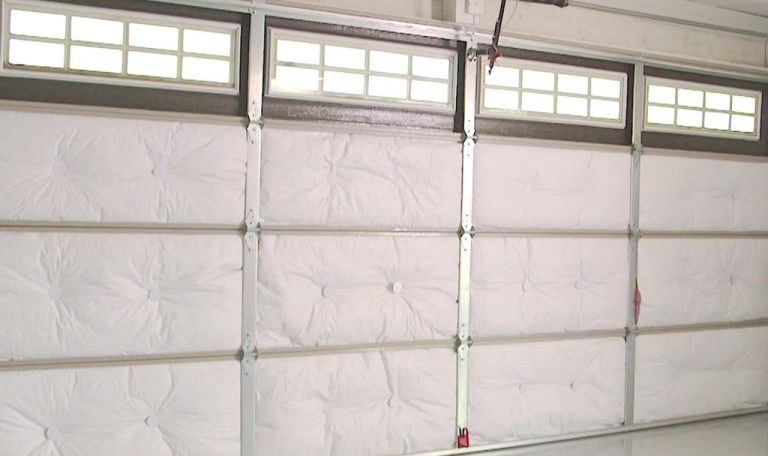Your garage door is likely the largest opening in your home—and without proper insulation, it’s a major source of heat loss in winter and heat gain in summer. By adding garage door insulation, you create a thermal barrier that stabilizes indoor temperatures and reduces the strain on your HVAC system. Benefits of garage door insulation include: Energy efficiency: Helps lower heating and cooling costs. Improved comfort: Keeps the garage usable in all seasons. Noise reduction: Blocks outside sounds and keeps indoor noise contained. Increased durability: Insulated doors tend to be more robust and long-lasting. In addition to these benefits, garage door insulation can also contribute to better indoor air quality. By creating a sealed environment, insulation helps keep out dust, pollen, and exhaust fumes that may otherwise enter through unsealed garage doors. This can be especially valuable for households with allergies or for those who use the garage as a workspace, gym, or hobby area. Types of Garage Door Insulation There are several types of garage door insulation available, and choosing the right one depends on your budget, climate, and DIY skills. Polystyrene Panels These foam boards are lightweight, easy to cut, and fit between garage door panels. They’re a popular choice for DIY installations. They offer a good balance between affordability and insulation performance, making them ideal for moderate climates. Polyurethane Foam This type is usually injected into the door during manufacturing but can be added later by professionals. It provides excellent thermal resistance. Because of its high R-value per inch, it’s especially effective in extreme temperature conditions. Reflective Foil Insulation Great for hot climates, reflective foil insulation reflects radiant heat away from the garage. It’s lightweight and moisture-resistant. Its thin design also makes it perfect for garages with limited space or low-clearance doors. Fiberglass Batts Often used in wall and attic insulation, fiberglass batts can also insulate garage doors. However, they require a protective cover to prevent exposure. They provide solid insulation but may be better suited for detached garages where aesthetics are less of a concern. How to Insulate Your Garage Door: A Step-by-Step Guide Tools & Materials Needed: Insulation kit or material of choice Utility knife or insulation cutter Measuring tape Adhesive or tape (as recommended) Safety gloves and goggles Step 1: Measure and Plan Measure each panel of your garage door to determine how much insulation you’ll need. Most kits come pre-cut for standard panels, but custom measurements may be required. Step 2: Choose Your Insulation Select the type of garage door insulation best suited for your climate and door material. Foam panels or reflective foil are excellent for DIY installs. Step 3: Install the Insulation Fit each insulation piece into the door panels snugly. Use adhesive or tape to secure them in place, ensuring a tight fit that eliminates gaps. Step 4: Seal Edges and Inspect After installing the insulation, seal any gaps with weather-stripping or caulk to maximize effectiveness. Test the door’s operation to ensure insulation doesn’t obstruct its movement. Maintenance Tips for Insulated Garage Doors Once your garage door insulation is in place, a few maintenance practices will keep it performing well: Inspect annually: Look for damage, sagging, or moisture buildup. Clean regularly: Use mild detergent and a soft cloth to clean the insulation surface. Replace damaged sections: If the insulation gets crushed or moldy, replace it promptly. Lubricate moving parts: Regularly grease the rollers, hinges, and springs to ensure smooth operation. When to Call a Professional While DIY insulation is achievable, some situations are best left to professionals. If your garage door is old, unbalanced, or you want premium-grade garage door insulation, a trained technician can provide expert installation and guidance. Why Hiring a Professional Is Worth It While adding garage door insulation can be a rewarding DIY project, hiring a professional offers several key advantages. Professionals bring expertise that ensures the insulation is installed correctly and efficiently, eliminating gaps that could compromise energy savings. They also have access to higher-grade materials and tools that may not be available in standard DIY kits, resulting in longer-lasting and more effective insulation. Moreover, a professional can assess your entire garage door system for issues that might interfere with insulation performance, such as alignment problems or worn components. This holistic approach not only improves insulation efficiency but also extends the life of your garage door. By relying on an experienced technician, you save time, avoid costly mistakes, and gain peace of mind knowing the job is done right. Contact Us


